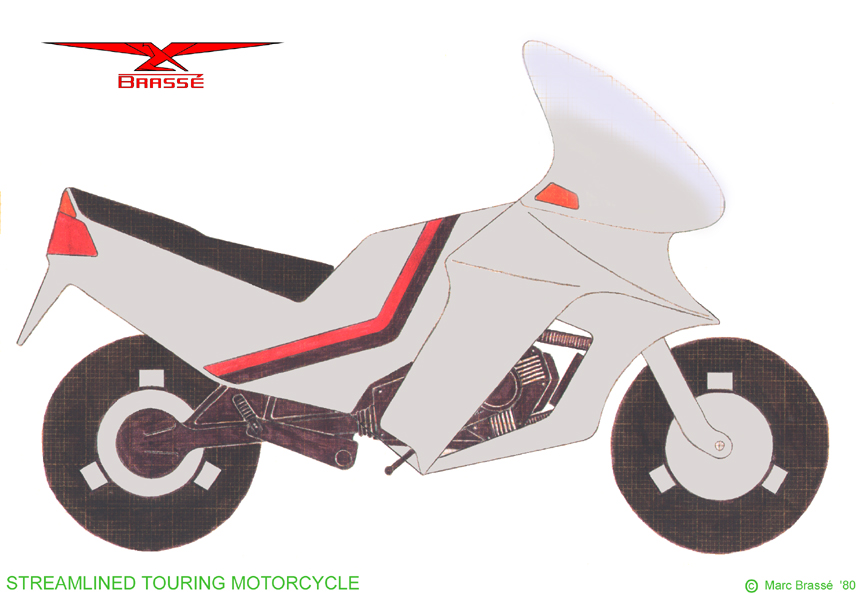 Early thoughts: This concept form 1980 (!) already shows much of the ergonomic and aerodynamic thinking behind the Pteranodon. They say that good whine takes time to mature. Or are some concepts just too advanced for their own time?
Early thoughts: This concept form 1980 (!) already shows much of the ergonomic and aerodynamic thinking behind the Pteranodon. They say that good whine takes time to mature. Or are some concepts just too advanced for their own time?
On this page you will find information about my motorcycle projects. All these bikes have been heavily modified and look distinctly different from the originals. I actually spend more time tinkering on them then riding but when the weather is nice and the road is calling...... Oh, then life is really good!

This design is my take on the ideal sports bike. It's not a pure racer nor a conventional sports tourer. It is intended more to be the near ultimate machine for swerving over bendy roads.
The idea was to make a shape that is as aerodynamic as possible without hiding the mechanics and / or turning the bike into a blob. One could compare it to the Formula 1 school of thinking, where regional treatment of the airflow takes presidence over the general shape. In the process I have been able to achieve quite a good mix between ergonomics and aerodynamics.
A very early inspiration was Luigi Colani's 1973 frog style study. This bike could be viewed as a practical translation of that rather extreme concept. At first sight the results are very different but one can find the clues. An example is the aerodynamic "channel" between the drivers arms and legs. This would not work on a pure racing bike but when the rider sits slightly more upright there is enough room between both the arms and the legs to lead a part of the the airflow around the riders waist, thus reducing drag.
The colors are also rather adventurous. Since I had already built 2 bikes with my favorite color combination (Red, silver, black. See the other project below) I thought it was time for something less conventional. So I added a "bit" of blue.
In the SCALE MODELING section a picture can be found of an earlier model, itself of course already based on preliminary sketches and drawings.
The actual motorcycle is based on the Yamaha XZ 550 from 1982. This was the first time Yamaha built a high performance sports touring V2. The market did not receive it very well. The angular styling probably was to blame. Yamaha dropped it before really ironing all its small weaknesses.
In essence it however is a very good design. Looking at it from todays perspective the overall engine concept is still surprisingly up to date (water cooled V2, 4 valves per cylinder. double overhead camshafts per cylinder head, direct "downdraft" intake channels, etc. etc.) The only thing it really misses, when compared to a newer bikes, is electronic injection. Even the power output of 64 bhp is not that low when compared to more recent incarnations of this layout. Suzuki has actually been very successful marketing the SV650 / Gladius family which is very similar in concept and power output (72 bhp at 100 cc extra). Another example is Aprilia's 2008 Shiver. True, it delivers more power (95 bhp) but it has 200 cc extra. At a constant bhp per liter level an XZ 550 with 650 cc would actually have an output of 75.6 bhp and at 750 cc it's output would be 87,3 bhp. So that's progress for you: Even after 32 years these power outputs are comparable!
This is my most thorough rebuild up to now. As always I left the engine alone. I have however been much bolder with the running gear then before. What was already good I kept but everything that could clearly be improved on was changed. The frame portion between the headstock and the rear axle has been thoroughly reinforced, the original being a bit rudimentary in places. Furthermore the rear frame and the foot peg mountings have been redesigned.
The frames geometry has also been slightly altered to a somewhat more front oriented stance. The headstock bearing is now cylindrical in stead of a ball bearing. The brakes where also upgraded quite heavily, now also featuring a disk at the rear wheel.
It's funny though how the design ages rather well. It might in some ways deviate from the norm (those "skinny" 18" wheels for instance) but these choices are based on very conscious considerations. My ideas are always dominated more by common sense then the latest fashion. It has at last run in earnest in the summer of 2015, no less then 11 years after the very first conceptual scribblings.
It also featured in a dedicated article in the August 2015 issue of german magazine Motorrad Classic. A very proud moment indeed, proving that sometimes persistence indeed pays of on the long run.
How it runs? Great. Exactly what I hoped for. It's nimble but stable.
 Early thoughts: This concept form 1980 (!) already shows much of the ergonomic and aerodynamic thinking behind the Pteranodon. They say that good whine takes time to mature. Or are some concepts just too advanced for their own time?
Early thoughts: This concept form 1980 (!) already shows much of the ergonomic and aerodynamic thinking behind the Pteranodon. They say that good whine takes time to mature. Or are some concepts just too advanced for their own time?

This was not an easy theme to work out. It tries to incorporate futuristic elements but in a sort of retro style. Influences are the 50ties dustbin racers, the 1953 NSU 250 Rennmax and Ducati's original 70's square case SS series.
The Grifone is based on a Ducatie 600 TL from 1982/83, the Pantah's less popular touring version. The engine is almost original. The only changes being a Conti 2 in 1 exhaust and K&N sports air intake filters. I am not sure if this has actually added any power but it sounds great, although a bit on the loud side.
The chassis is completely original. The Pantah's where very good sports bike so I never felt much need to alter this bike in that respect. The design and ergonomics are en entirely different matter though. One could basically say that everything that is painted silver on this bike is totally of my own design and manufacturing.
Although I liked the overall shape from the start I made some minor changes throughout it's active life and am now more or less satisfied with the result.
In case somebody is wondering: This original design is from 1988 and thus predates all of Ducati's retro design efforts by Pierre Terblanche.

When I was young german 50 cc's were the thing to own for a 2 wheel fanatic teen. This project has actually been built much later then it's original early 80ties paper design and could therefore also be classified as retro.
Basically it is my take on the super-"brommer" I dreamt of as a 16 year old but never could afford at the time. If it had been built that early it would not have made a bad impression at all when compared to what ran around at the time. In reality I had to finish that dream at a much later date. Some things just take a bit longer, I guess.
The bike is based on a Zündapp K80, one of the last models that this brand produced. It has a tubular frame rather then the cast aluminum structures Zündapp was famous for. Styling cues for my version came from the original fire-red Hercules Ultra 50 cc bike and the Moto Guzzi Le Mans III. The latter was of course a much larger motorcycle but when put side by side one can certainly see the similarities. Call it an attempt to combine German sturdiness with Italian flair.
This little curve hunter has a 92.3 cc capacity. With the original restrictive K80 exhaust and a rather short gearing it already runs 95 km/h on its speedo. A properly designed racing expansion exhaust and the right gearing could add a lot more to that. In it's present form it however already is a very nice 2 wheel cart.
I wish I still had the right build to match it. Luckily my son Raphael, fits better. Look at that totally period style denim ensemble he is wearing!
Now what about them? Do you like my motorcycles? I surely hope so but will not be devastated if you don't. When push comes to shove these bikes only have to please me. They are not the result of marketing surveys or general trends.
Some additional remarks:
Question: There are so many impressive machines around. Why am I always tinkering with young- / old timers?
First of all I like the idea of a vehicle being totally unique. Any moron can buy a faceless factory product and kid himself into thinking he has become more interesting because of it.
Things are entirely different however when one actually builds his own bike. To fabricate almost everything myself with the most rudimentary tool set and do all the grinding, sanding and painting by hand is very satisfactory. Call it the sheer Zen of it. Then the positive, call them artisan aspects, start to transcend the simple materialism of just owning a bike.
There also is the nostalgic factor. The late 70's / early 80's where the times when the motorcycle evolved into the entity we know today. Electronic ignition and injection systems, disk brakes, cast wheels: As far as production motorcycles are concerned these items became standard around this time. Of course todays motorcycles are more refined and need less maintenance but many are overly complicated, characterless impersonators. Worst of all: In spite of all marketing suggesting otherwise they keep getting heavier and thirstier.
Another factor are budgetary constraints. Getting paid for being an out of the box thinker has proven to be very elusive (see the rest of my endeavors). That's why I am in practice held to rather tight budgets. Customizing older motorbikes can however be done relatively cheap and so I started to turn ugly old bikes into sporty specials years before café racers became trendy again.
Lastly there is the symbolism of freedom that bikes pervade. I do not feel much connected to the death defying motorcycle rebel image though. What I see in my mind is man forming a single entity with his machine in a sort of centaur way, while swooshing over the most winding road imaginable. Call it the freedom of simply being yourself.
In short: I tinker with motorcycles because of my fascination with technology, my individualism, my perfectionism and my need to distance myself from the madding crowd. What more can one gain from a hobby?
Nowadays building a cafe racer is all the rage again. The dates of my projects proof that I was already infected by that virus long ago. My bikes are not typical cafe racers anyway. My approach goes much further then selecting existing parts and putting them together. When I define the concept for a new project my first idea's always point to something really advanced and up to date. Preferably something that could change the way we perceive the concept of motorcycling. If I look at my earliest sketches from around 1980 I see premonitions of things that exist now but even of things that still have to happen.
After sketching I often build a model to check out how practical the shape that I have in mind really is.
Then the real building starts. This is always a very prolonged process.
Most work goes into building the GRP (Glass-fiber Reinforced Polyester) body parts. I start with shaping a preliminary foam model over the motorcycle. If that has the right shape I put a few layers of GRP over it. Then these rough parts are sanded, filled, sanded, filled, etc. until I am satisfied with the result.
So I hardly ever make a mold. What I ride are the actual prototypes.
The next step is is to fabricate all the small parts needed to fit everything together. This is again done with only a very basic set of tools.
Then comes the most dreaded bit. The painting. On the Pteranodon I even did almost all the painting with a brush, then spent lot of time sanding every layer down, repainting, sanding, repainting, ... er... , you get the picture. To a typical consumer this might all sound very tiresome but, like I already pointed out, part of the attraction is the Zen of being buzzy in a creative way. Even during the boring bits.
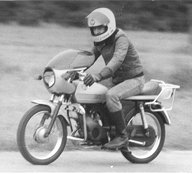
| 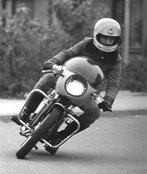
| 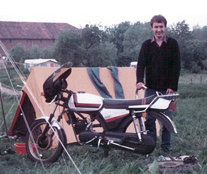
| 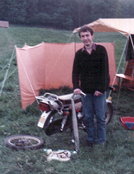
|
This is my very first motorized two wheeler. It was a banged up old Zündapp CS50. I "inherited" it from my father in the late 70ties. You can see it here in 2 of its many evolutionary stages. Maybe it's not that impressive as such but it proves how early I had been bitten by the design bug. I actually still own it, in the shape of a whole pile of loose parts.

The fact that I do not concern myself too much with originality does not mean I am not a stickler for detail. What about this little tale?
I like the design of the Pantah engine a lot. One of it's nice little details is the dedicated Pantah logo. On most surviving machines it disappeared years ago but I managed to keep mine in a reasonable state until recently by now and then simply touching up the corners with a permanent marker. While remounting the tank/fairing assembly of my Grifone after a recent respray some petrol however dripped on the sticker and it went the same way as all the others.
"Well, then I'll just make myself a new one", I thought. "I'll simply download the logo from the INTERNET, print it and presto!" No chance!. I couldn't find that darn logo anywhere! The engine stickers themselves seem to be only original source.
Time to get creative. Starting from the more widely used, Cagiva era, double line Ducati logo I have been able to recreate the Pantah logo. That took a lot of digital cutting, pasting, measuring, stretching and resizing but the end results is a perfect template.
Just in case anybody else wants to use that original design again a link to the JPEG file has been included below.
I actually made the letters gray, printed the logo on a white paper sticker, covered that with transparent foil and glued the result on the engine cover. Off course the letters are now not silver but one has to look very careful to see the difference. For me it's good enough but one can of course also take the file to a professional printer.
Have fun!
Right click here to download the logo